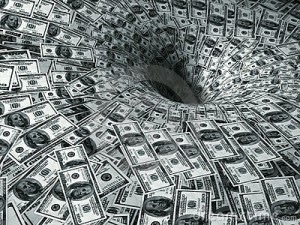Jeff Clark of
Casey Research has created a wonderful historical "art" album which addresses the number one question which most people living in the US right now are unable to fathom: how can one's currency go from X to 0. It is impossible. It certainly can not happen to the dollar. Right? Well, as Jeff says: "
History has a message for us: No fiat currency has lasted forever. Eventually, they all fail. You might suspect this happened only to third world countries. You’d be wrong.
There was no discrimination as to the size or perceived stability of a nation’s economy; if the leaders abused their currency, the country paid the price." We may add one other thing: no country in the history of the world has imploded from hyperdeflation.
Not one. At the point where the debt load was insurmountable and not enough cash flow was being generated to sustain it, the authorities would always find a way to step in and be the terminal source of dilutive fiat demand: from ancient Rome, to Weimar, to the collapse of the Soviet Block, to, inevitably, the unwind of the failed (neo) Keynesian model, where we are right about now. Sure, we can all come up with goalseeked theories that validate our perspective but they are all meaningless at the end. Past a given threshold debt money ceases to function as backed by the full "faith and credit" of the backstopper and is nothing but paper. Yes. Even the abstract concept of so-called "reserve" currencies. Quote Clark: "As you scroll through the currencies below, you’ll see some long-ago casualties. What’s shocking, though, is how many have occurred in our lifetime. You might count how many currencies have failed since you’ve been born." There are many more where these came from. Thousands in fact. Which brings us to the title of this post. What are all these images, which is really all they are now - fancy paperweights (no pun intended) from near and far history, worth now? Precisely.

Yugoslavia – 10 billion dinar, 1993
Zaire – 5 million zaires, 1992
Venezuela – 10,000 bolívares, 2002
Ukraine – 10,000 karbovantsiv, 1995
Turkey – 5 million lira, 1997
Russia – 10,000 rubles, 1992
Romania – 50,000 lei, 2001
Central Bank of China – 10,000 CGU, 1947
Peru – 100,000 intis, 1989
Nicaragua – 10 million córdobas, 1990
Hungary – 10 million pengo, 1945
Greece – 25,000 drachmas, 1943
Germany – 1 billion mark, 1923
Georgia – 1 million laris, 1994
France – 5 livres, 1793
Chile – 10,000 pesos, 1975
Brazil – 500 cruzeiros reais, 1993
Bosnia – 100 million dinar, 1993
Bolivia – 5 million pesos bolivianos, 1985
Belarus – 100,000 rubles, 1996
Argentina – 10,000 pesos argentinos, 1985
Angola – 500,000 kwanzas reajustados, 1995
Zimbabwe – 100 trillion dollars, 2006
Clark concludes:
So, will a similar fate befall the U.S. dollar? The common denominator that led to the downfall of each currency above was the two big Ds: Debts and Deficits.
With that in mind, consider the following:
Morgan Stanley reported in 2009 that there’s “no historical precedent” for an economy that exceeds a 250% debt-to-GDP ratio without experiencing some sort of financial crisis or high inflation. Our total debt now exceeds GDP by roughly 400%.
Investment legend Marc Faber reports that once a country’s payments on debt exceed 30% of tax revenue, the currency is “done for.” On our current path, analyst Michael Murphy projects we’ll hit that figure by October.
Peter Bernholz, the leading expert on hyperinflation, states unequivocally that “hyperinflation is caused by government budget deficits.” This year’s U.S. budget deficit will end up being $1.5 trillion, an amount never before seen in history.
Since the Federal Reserve’s creation in 1913, the dollar has lost 95% of its purchasing power. Our government leaders clearly don’t know how – or don’t wish – to keep the currency strong.
Whether the dollar goes to zero or merely becomes a second-class currency in the global arena, the possibility of the greenback being added to the above list grows every day. And this will lead to serious and painful consequences in our standard of living. While money is only one of many problems we’ll have to deal with, you can protect your assets with the one currency that can’t be debased, devalued, or destroyed by irresponsible leaders.
Because when it comes to money, worthless is not a fun word.
 -1.66 (-20.32%)
-1.66 (-20.32%)  ] and Alcoa[AA 11.33
] and Alcoa[AA 11.33  -1.46 (-11.42%)
-1.46 (-11.42%)  ].
]. -1.66 (-20.32%)
-1.66 (-20.32%)  -1.46 (-11.42%)
-1.46 (-11.42%) 
























